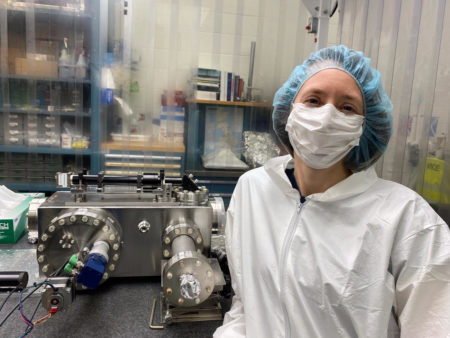
What is your role with ALS and the ALS-U Project?
I’ve been working on the ALS Upgrade (ALS-U) Project full time for the past five years, primarily in the R&D area. I’ve been involved with the wavefront sensor, and I also helped a bit with the high-heat-load optics. In the last year-and-a-half, I have started co-leading the quality assurance effort with Kyle La Fleche for Beamlines and Optical Systems. I’m also the custodian of the clean optics storage facility for ALS-U, and the cabinet for that is in my lab in the basement of 80.
Recently, I started working on a project on the ALS side, getting a portable plasma cleaning unit together. It utilizes what Jamie Nasiatka and Daniele Cocco have learned from developing optics cleaning procedures on their test setup in Building 2. They have been doing a lot of experimentation with different gases to clean optics using a plasma generator and some mass flow controllers that control the mixture, with the goal of cleaning optics, most especially of carbon.
What did you do before you came to the ALS?
I actually started at the Lab many years ago as a student at the 88-inch Cyclotron. Then I was an operator at the Cyclotron for a brief period of time. After that, I came up to the ALS as an operator, and then I was a scientific engineering associate (SEA) with the Berkeley Center for Structural Biology for almost 11 years. Actually, this month marks five years that I have officially been with the ALS.
What do you like most about your job?
I think the thing I like most about my current role is that I get to wear a lot of different hats. I think that working on ALS-U is probably the most similar thing to working at a startup within the Lab. There have been opportunities to do lots of different things, because, especially at the beginning, there were not a lot of people working on it. And so basically any time that you had an ability in an area, you had the opportunity to help in that effort. I really like that. Also, I work with fantastically talented people. It’s brilliant what the Lab does, especially the ALS, with the comparatively small budget that we have. If people understood just how much we are able to do with so little, I think they would be rightly impressed with that.
I’m very fortunate to work with many very talented, smart, and kind human beings. The quality assurance work has given me the opportunity to have ownership of something, on a level that I have never been able to have thus far in my career, and I have really been enjoying that as well.
You are involved with the ALS’s Inclusion, Diversity, Equity, and Accountability (IDEA) task forces. What do you see as the biggest obstacle in furthering IDEA?
 I got involved as soon as the IDEA task forces got established. As soon as I heard that there was a career and professional development task force, I made a beeline right for that, because that is something I’m very passionate about, and now I chair the task force. I personally have a strong interest in seeing more career and professional development at the ALS especially, but also at the Lab in general.
I got involved as soon as the IDEA task forces got established. As soon as I heard that there was a career and professional development task force, I made a beeline right for that, because that is something I’m very passionate about, and now I chair the task force. I personally have a strong interest in seeing more career and professional development at the ALS especially, but also at the Lab in general.
As far as obstacles in furthering IDEA, I think there is inertia to new ideas and new systems. It has nothing to do with the Lab; that is just human nature.
Do you have any interesting hobbies?
I have been an avid climber for many years. I have had a number of hobbies over the years, but I tend to get bored with things pretty quickly. Many of my hobbies have been around physical movement of different kinds. I did acro yoga and aerial tissue, but climbing has been the only one that has really stuck. I think that’s because it is unlike any other sport, at least in my experience. It is highly physical, but there is also a very specific and large mental component to it. I find climbing extremely meditative; everything else falls away when I’m on a route. I find that very grounding and centering.